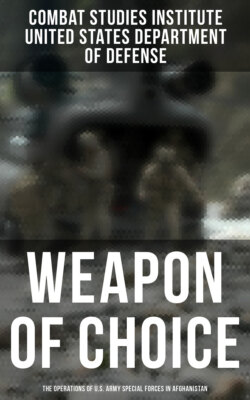Читать книгу Weapon of Choice: The Operations of U.S. Army Special Forces in Afghanistan - Combat Studies Institute - Страница 30
На сайте Литреса книга снята с продажи.
Hot-Wiring the “Snake”: Rearranging JSOTF-North Communications
ОглавлениеThe 112th signalers, 5th SFG, and Air Force communications personnel scrambled fast to accommodate the rearrangement while supporting the CSAR mission and anticipating the UW campaign. MSG Don Sullivan (pseudonym), the 5th SFG communications chief, and MAJ Derrick Jacobi (pseudonym), the 5th SFG signal officer, accompanied COL Mulholland from Fort Campbell. Their initial mission was to provide communications for the two SF ODAs that were on “strip alert” at K2, ready to take off by helicopter at a moment’s notice to search for and rescue any U.S. Air Force aircrews that had bailed out of their aircraft during the air campaign while bombing targets, dispersing propaganda leaflets, or dropping humanitarian relief in Afghanistan.
MAJ Jacobi had been made the JSOTF-North communications and electronics staff officer (J6) responsible for continuous and reliable telecommunications. His principal assistant was MSG Sullivan, a former chef and top-notch tennis player with an undergraduate degree in medieval history and Islamic studies. Why the entire 5th SFG staff was going to Uzbekistan to set up a base for two ODAs was a mystery to Sullivan, despite having the same security clearances as the principal commanders and staff officers and having helped design the networks for the operation. His “need to know” did not extend beyond the initial planning for CSAR. Whatever the reason, Sullivan focused on his key task—ensuring that the 5th SFG commander always “got the information he needed to do his job.”
That meant rapidly integrating the established Air Force and 112th Signal Battalion communications array to best support the JSOTF-North headquarters without losing voice and digital message connectivity because the JSOAC was already coordinating flights of MC-130P tankers and 160th SOAR helicopters to perform the CSAR mission. The 5th SFG soldiers built their “tent city” operations center first, setting up work tables, desks, and chairs and hanging wall charts and maps in the principal staff areas. The 5th SFG’s communications section then shifted half of the Air Force network setup from its principal location in several abandoned buildings on the opposite end of the runway.
Figure 50. The support battalion needs communications to provide support.
Then MAJ Jacobi’s communications section established the network systems and tactical communications links and brought them operationally “on-line.” Having completed this, they took the Air Force communications “off-line” and walked together with them, helping to carry wiring harnesses, equipment, and other connectors down the runway to new workstations in the Snake. Next, they were “logged back in” through the digital network “cloud.” The other half of the network then followed, with all its hardware and cables being incorporated in the eight-section “temper tent” that was the joint operations center (JOC) for the JSOTF headquarters. Thus, operational communications were never lost, despite the rapid relocation of equipment and personnel. With the 112th Signalers and the Air Force communications element helping, the joint base station was completed in less than 48 hours. “We went from dirt to a functional J6 in thirty-six hours—bottom line—it worked,” reported MAJ Jacobi.
Shortly after COL Mulholland arrived at K2, CPT Steve Marks (pseudonym), commander, A Company, 112th Signal Battalion, was tasked to be fully mission capable to support future missions by 13 October. Marks, having successfully led his unit during Operations JOINT ENDEAVOR and JOINT GUARDIAN, was determined not to be the weak link in supporting those missions. The 112th Signalers met the challenge and established a secure video teleconferencing (VTC) link from the theater back to the United States. At the height of combat operations, A Company was conducting 10 to 14 VTCs a day. These conferences enabled the TF Dagger and JSOAC commanders to provide real-time reports, to recommend future operations, and to receive guidance directly from CENTCOM’s leaders in Tampa. First Sergeant (1SG) Martin Masterson (pseudonym) summed up the unit’s performance: “We don’t fail; we just don’t fail.”
